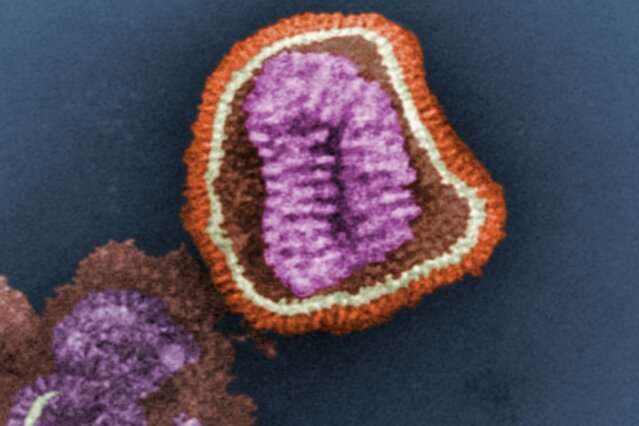
Why some influenza viruses are more dangerous than others
by Susanne Stöcker, Paul-Ehrlich-Institut – Bundesinstitut für Impfstoffe und biomedizinische Arzneimittel

Serious infections with influenza A viruses are characterized by an excessive immune response, known as cytokine storm. It was previously unclear why some virus strains trigger these storms, while others do not. Researchers at the Paul-Ehrlich-Institut investigated 11 different influenza A virus strains and their effect on different human immune cells.
The results, published in Emerging Microbes & Infections, show that highly pathogenic avian influenza viruses infect specific kinds of immune cells and thus stimulate the production of type I interferon. This could explain why these viruses are particularly dangerous.
“Our research results show that not only the immune cells that have always been the focus of attention regarding type I interferon production, but also other immune system cells could be decisive in whether an influenza infection triggers an excessive immune system response. This knowledge is important in order to be able to better assess the risk of dangerous virus variants,” summarizes Professor Zoe Waibler, Vice President (acting) of the Paul-Ehrlich-Institut.
Influenza viruses are some of the most significant respiratory disease pathogens worldwide. While most infections are relatively mild, certain virus strains can cause severe pneumonia, leading to acute respiratory failure. Highly pathogenic influenza viruses are particularly dangerous. They often spread from birds to humans and are associated with significantly higher mortality rates.
The immune system plays a crucial role in this danger: some virus strains cause the body to release an excessive amount of messenger substances known as cytokines. If a cytokine storm occurs, the immune response will end up damaging the body’s tissue more than the virus itself.

But why do some influenza viruses trigger such excessive reactions, while others only cause infections with mild progression? The research team, led by Dr. Martina Anzaghe, Research Immunology Section, sought to better understand this reaction.
Working together with the Virology Department at the University Hospital Freiburg, the team investigated 11 different influenza A virus strains—both common seasonal influenza viruses and highly pathogenic avian influenza viruses. They tested how the flu viruses infect different immune cells and stimulate the release of messenger substances.
The aim of their research is to decipher the mechanisms behind mild and severe disease progression and to develop long-term approaches for better protection and treatment options.
Key role played by certain immune cells in severe influenza
The investigations showed that a certain type of immune cell, so-called plasmacytoid dendritic cells, produce large amounts of the important antiviral messenger interferon-α (IFN-α) upon infection with influenza—regardless of the virus strain. This means that these immune cells generally respond strongly to influenza viruses without the need for the virus to productively infect them.
If this is the case, why do not all viruses cause the same severity of the disease? The research team found that other immune cells, namely myeloid dendritic cells and different types of macrophages, are infected with highly pathogenic influenza viruses and produce large amounts of IFN-α. Viral replication in these immune cells appears to be an important factor in the production of type I interferon and the development of an excessive immune response (cytokine storm).
These results provide an explanation of why some influenza viruses could be so much more dangerous than others: it might be their ability to replicate in certain immune cells and thereby trigger an extremely strong immune reaction that leads to severe inflammation and harm to health. This knowledge can help to develop targeted therapies and better identify risk groups.
More information:
Marc A. Niles et al, Influenza A virus induced interferon-alpha production by myeloid dendritic cells and macrophages requires productive infection, Emerging Microbes & Infections (2025). DOI: 10.1080/22221751.2025.2556718
Provided by
Paul-Ehrlich-Institut – Bundesinstitut für Impfstoffe und biomedizinische Arzneimittel
Citation:
Why some influenza viruses are more dangerous than others (2025, September 9)
retrieved 9 September 2025
from https://medicalxpress.com/news/2025-09-influenza-viruses-dangerous.html
This document is subject to copyright. Apart from any fair dealing for the purpose of private study or research, no
part may be reproduced without the written permission. The content is provided for information purposes only.



